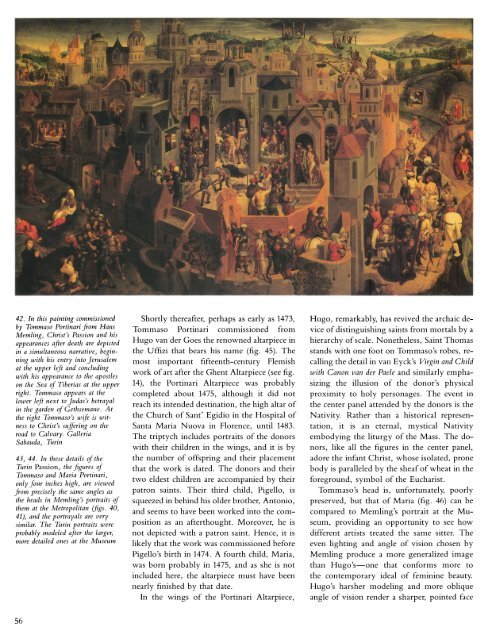Early Flemish Portraits 1425-1525: The Metropolitan Museum of Art ...
Early Flemish Portraits 1425-1525: The Metropolitan Museum of Art ...
Early Flemish Portraits 1425-1525: The Metropolitan Museum of Art ...
You also want an ePaper? Increase the reach of your titles
YUMPU automatically turns print PDFs into web optimized ePapers that Google loves.
42. In this painting commissioned<br />
by Tommaso Portinari from Hans<br />
Memling, Christ's Passion and his<br />
appearances after death are depicted<br />
in a simultaneous narrative, beginning<br />
with his entry into Jerusalem<br />
at the upper left and concluding<br />
with his appearance to the apostles<br />
on the Sea <strong>of</strong> Tiberias at the upper<br />
right. Tommaso appears at the<br />
lower left next to Judas's betrayal<br />
in the garden <strong>of</strong> Gethsemane. At<br />
the right Tommaso's wife is witness<br />
to Christ's suffering on the<br />
road to Calvary. Galleria<br />
Sabauda, Turin<br />
43, 44. In these details <strong>of</strong> the<br />
Turin Passion, the figures <strong>of</strong><br />
Tommaso and Maria Portinari,<br />
only four inches high, are viewed<br />
from precisely the same angles as<br />
the heads in Memling's portraits <strong>of</strong><br />
them at the <strong>Metropolitan</strong> (figs. 40,<br />
41), and the portrayals are very<br />
similar. <strong>The</strong> Turin portraits were<br />
probably modeled after the larger,<br />
more detailed ones at the <strong>Museum</strong><br />
Shortly thereafter, perhaps as early as 1473,<br />
Tommaso Portinari commissioned from<br />
Hugo van der Goes the renowned altarpiece in<br />
the Uffizi that bears his name (fig. 45). <strong>The</strong><br />
most important fifteenth-century <strong>Flemish</strong><br />
work <strong>of</strong> art after the Ghent Altarpiece (see fig.<br />
14), the Portinari Altarpiece was probably<br />
completed about 1475, although it did not<br />
reach its intended destination, the high altar <strong>of</strong><br />
the Church <strong>of</strong> Sant' Egidio in the Hospital <strong>of</strong><br />
Santa Maria Nuova in Florence, until 1483.<br />
<strong>The</strong> triptych includes portraits <strong>of</strong> the donors<br />
with their children in the wings, and it is by<br />
the number <strong>of</strong> <strong>of</strong>fspring and their placement<br />
that the work is dated. <strong>The</strong> donors and their<br />
two eldest children are accompanied by their<br />
patron saints. <strong>The</strong>ir third child, Pigello, is<br />
squeezed in behind his older brother, Antonio,<br />
and seems to have been worked into the composition<br />
as an afterthought. Moreover, he is<br />
not depicted with a patron saint. Hence, it is<br />
likely that the work was commissioned before<br />
Pigello's birth in 1474. A fourth child, Maria,<br />
was born probably in 1475, and as she is not<br />
included here, the altarpiece must have been<br />
nearly finished by that date.<br />
In the wings <strong>of</strong> the Portinari Altarpiece,<br />
Hugo, remarkably, has revived the archaic device<br />
<strong>of</strong> distinguishing saints from mortals by a<br />
hierarchy <strong>of</strong> scale. Nonetheless, Saint Thomas<br />
stands with one foot on Tommaso's robes, recalling<br />
the detail in van Eyck's Virgin and Child<br />
with Canon van der Paele and similarly emphasizing<br />
the illusion <strong>of</strong> the donor's physical<br />
proximity to holy personages. <strong>The</strong> event in<br />
the center panel attended by the donors is the<br />
Nativity. Rather than a historical representation,<br />
it is an eternal, mystical Nativity<br />
embodying the liturgy <strong>of</strong> the Mass. <strong>The</strong> donors,<br />
like all the figures in the center panel,<br />
adore the infant Christ, whose isolated, prone<br />
body is paralleled by the sheaf <strong>of</strong> wheat in the<br />
foreground, symbol <strong>of</strong> the Eucharist.<br />
Tommaso's head is, unfortunately, poorly<br />
preserved, but that <strong>of</strong> Maria (fig. 46) can be<br />
compared to Memling's portrait at the <strong>Museum</strong>,<br />
providing an opportunity to see how<br />
different artists treated the same sitter. <strong>The</strong><br />
even lighting and angle <strong>of</strong> vision chosen by<br />
Memling produce a more generalized image<br />
than Hugo's-one that conforms more to<br />
the contemporary ideal <strong>of</strong> feminine beauty.<br />
Hugo's harsher modeling and more oblique<br />
angle <strong>of</strong> vision render a sharper, pointed face

















